Cheomseongdae › Cheonmachong › Dolmens of Ancient Korea » Origins and History
Articles and Definitions › Contents
- Cheomseongdae › Origins
- Cheonmachong › Origins
- Dolmens of Ancient Korea › Origins
Ancient civilizations › Historical places, and their characters
Cheomseongdae › Origins
Definition and Origins
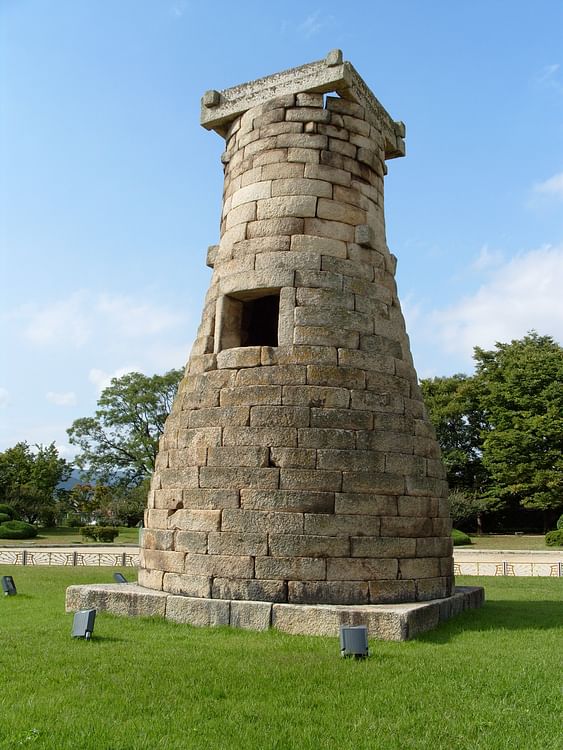
Cheomseongdae (Chomsongdae) is a 7th-century CE observatory tower located in Gyeongju (Kyongju), the capital of the Silla Kingdom of ancient Korea. It is the oldest surviving astronomical observatory in East Asia and is listed as no. 31 on the official list of National Treasures of Korea.
GYEONGJU – CITY OF ARTS & SCIENCE
It is believed that the observatory tower, sometimes known as the Cheomseongdae Royal Observatory, was, according to the 13th-century CE Samguk yusa text, built in the early years of the reign of Queen Seondeok (632-647 CE), who reigned just before the Silla kingdom would reach the height of its prosperity and go on to control all of the Korean peninsula in 668 CE.The capital at Gyeongju became a centre of culture, arts, and science with a particular flourishing in mathematics, astronomy, and astrology. It is likely that the Cheomseongdae tower was the centrepiece of an entire scientific district, such was the importance given to the effect of celestial bodies on human affairs in Korean culture. The name Cheomseongdae may be translated as the 'reverently regarding the stars platform.'
DESIGN & FUNCTION
The granite observatory tower is constructed in the shape of a bottle. Nine metres (29 ft) tall, it was made using 362-5 (scholars cannot agree on the exact number) large stone rectangular blocks set in a circular arrangement of 27 courses.These numbers are significant according to some historians. The number of blocks symbolises the days of the year and Queen Seondeok was the 27th monarch of the Silla kingdom. Further, the small square window of the tower is so positioned that there are 12 layers of bricks above and below it, representing the calendar months. The tower stands on a square base constructed using a single course of bricks. The tower narrows as it rises and is topped by a square platform made from eight long blocks, two on each side. The overall design is thus thought to encapsulate the traditional Chinese worldview of the 'round-heaven, square-earth.'
THE TOWER ACTED LIKE THE GNOMON OF A SUNDIAL. IT ALSO HAS A SOUTH-FACING WINDOW WHICH CAPTURES THE SUN'S RAYS ON THE SPRING & AUTUMN EQUINOXES.
The tower acted like the gnomon of a sundial. It also has a south-facing window which captures the sun's rays on the interior floor on the spring and autumn equinoxes. Originally there may also have been an armillary sphere (model of celestial bodies) on top of the tower. Astronomy and astrology were an important part of everyday life in ancient Korea, governing such activities as agriculture and giving divine authority to the actions of the sovereign. The science of observation was also highly developed and Silla scientists produced detailed star charts, no doubt, using such observatories as Cheomseongdae.
ALTERNATIVE THEORIES
More controversial theories as to the purpose of the tower are that it was designed to imitate the holy Buddhist mountain Mt.Sumeru and was a site of worship and prayers of the state religion at that time. Another theory is that the tower was built in honour of the Mesopotamian goddess Ishtar ( Inanna ), who was associated with the heavens and who may have been worshipped by Queen Seondeok. Still another suggestion is that the tower represents the female form and was, therefore, a temple dedicated to worship of the queen, the first female ruler in the history of the Silla kingdom. Lacking any convincing evidence to support such propositions, however, the scholarly consensus remains that the tower was, in fact, an observatory.
This article was made possible with generous support from the British Korean Society.
Cheonmachong › Origins
Definition and Origins
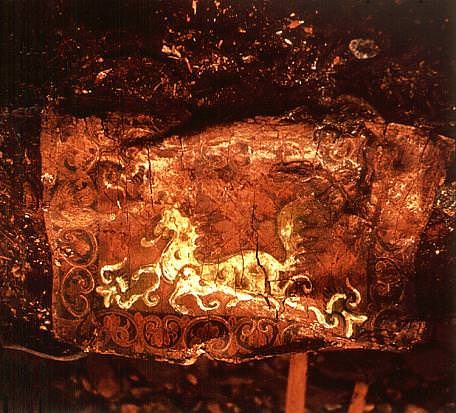
Cheonmachong is a 5-6th-century CE royal tomb of the ancient Silla kingdom of Korea located at the Daereungwon Tomb Complex in Gyeongju. It is popularly known as the 'Heavenly Horse Tomb' because of a painting of that animal on a birch-bark saddle-flap found within it. There were over 140 other treasures inside which included a magnificent gold crown, gold jewellery, a gold girdle, and a blue glass cup. Several items from the tomb feature on the official list of National Treasures of Korea.
TOMB DESIGN
The tomb was excavated in 1973 CE at Gyeongju (Kyongju) the former capital of the Silla kingdom then known as Kumsong or Sorabol. The Silla kingdom ruled the south-eastern portion of Korea between the 1st century BCE and 7th century CE. It would then go on to control the whole peninsula from 668 to 935 CE. Unlike in some other Silla mound tombs, there is no inscription plaque inside it to indicate exactly who the occupant was, but the richness of the artefacts within it and the presence of a gold crown would suggest it is the tomb of a Silla king. The tomb chamber is wood-lined and was covered in a stone mound with layers of clay set between the stones to make the tomb waterproof. Then the whole was covered in an earth mound, leaving no access point. This meant that the tomb did not suffer looting like many other Korean tombs of the Three Kingdoms periodwhich had horizontal entrance passages. The tomb measures 12.7 metres in height and has a diameter of 47 metres.
THE GOLD CROWN
The gold crown found in the tomb, like those from other Silla tombs, is composed of three parts which may have been intended to be worn all together. However, their location in three separate parts of this tomb may indicate that was not the case. The three elements are a diadem, gold cap, and wing-like appendages, presumably to be fitted into the cap. It is not clear whether the crown was meant to be worn, with some scholars suggesting it too delicate and others pointing out wear and tear marks on them which suggest they were used by the occupant when alive.
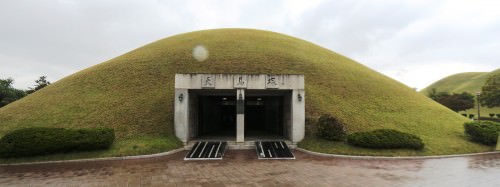
Cheonmachong ('Heavenly Horse Tomb')
The diadem is fitted with tall upright antlers (at the sides) and tree-like formations with U-shaped branches (at the front), which indicate a link with Scytho-Siberian shamanism. Made of thin pieces of cut sheet-gold they are embellished with granulation, punched dots, rivetting, filigree, and suspended disks or spangles. The crown is 32.5 cm high and is the most lavishly decorated of all the Silla crowns so far found. It has pendants of twisted gold ending in 58 crescent-shaped jade pendants known as gogok in Korean and very similar to those found in ancient Japan where they are called magatama ; they symbolise new life. Two gold chain pendants hang from either side of the crown and end in a three-dimensional pointed-leaf shape. They both have leaf-shaped spangles and an extra addition of gold bunched leaves and spangles at the top much like Silla earrings in design. The crown is number 188 on the official list of National Treasures of Korea.

Silla Gold Crown from Cheonmachong
The gold cap, another National Treasure (no. 189), is around 18 cm in height and made from four separate gold sheets which display various intricate openwork patterns. The sheets are joined together by gold rivets and wiring while the rim has decorative punched holes. The wing-like parts of the ensemble, two individual pieces, may represent bird's wings which were potent symbols of Korean shamanism as they symbolised flight in the spiritual world. One wing is made from three gold sheets, measures 45 cm across, and is decorated with over 400 tiny spangles individually attached with gold wire. The second wing piece resembles an angel with spread wings, measures 21.5 x 22 cm, and is similarly decorated with spangles and embossed circles along its edges.
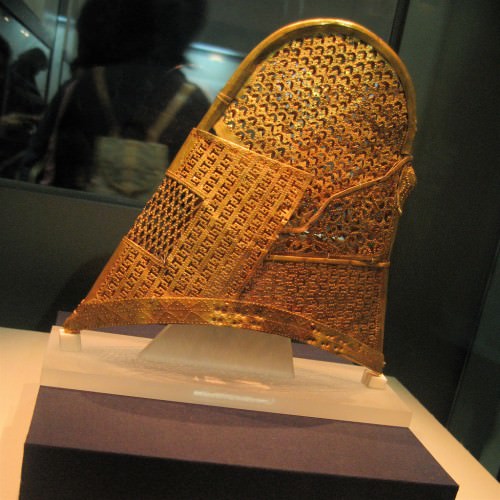
Gold Silla Cap
THE HEAVENLY HORSE
Horses had long been of importance in ancient Korean culture. Traditionally the peninsula was considered to have been first settled by horse-riders from the north, and many tombs contain horse trappings. Horses were also an export to Korea's major trading partner China over the centuries. A horse was sacrificed with the king of this tomb and a birch-bark flap on its saddle is painted with a figure of a white winged horse which has given the tomb its popular name of the 'Heavenly Horse Tomb'. The horse is painted in full gallop with flaring mane and tail. It also has curious crescent-shaped markings on its body which some scholars link to inlaid jades from Scythia. It is one of the earliest paintings of ancient Korea. Other saddle flaps in the tomb, carefully stored in a wooden chest, are similarly painted but this time with horsemen and one with a phoenix.
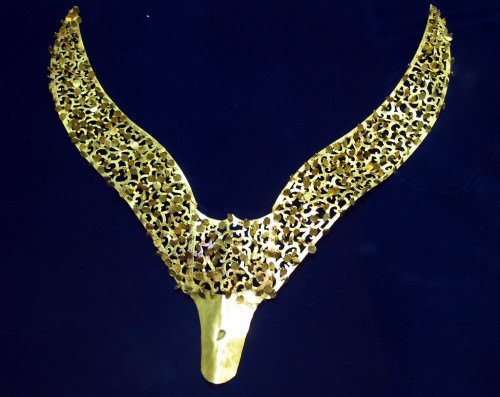
Gold Silla Crown Ornament
OTHER TREASURES
The occupant of the tomb was placed in a wood coffin which was laid on a stone platform. Inside was a sword, the gold diadem of the crown, and the body wore gilt-bronze openwork shoes and various jewellery items – earrings, rings, bracelets, and a magnificent gold girdle. The girdle, another National Treasure (no. 190), measures 125 cm and has 13 pendants, the longest being 73.5 cm long. The belt has dragon carvings decoration and consists of 44 thin joined gold plates with a buckle and tongue at each end. The gold pendants are miniature representations of tools and items perhaps worn by state officials, a tradition probably based on the practice of nomadic tribes-people wearing real tool belts. The pendants include tweezers, a small knife, two writing tablets, a fish, a perfume bottle, two jade gogok, and a weight. Finally, outside the coffin and stored in a chest were various horse trappings, bronze bowls and cups, glass beads, lacquer work, and pottery.
[bks]
Dolmens of Ancient Korea › Origins
Ancient Civilizations
Dolmens (in Korean: koindol or chisongmyo ) are simple structures made of monolithic stones erected during the late Neolithic period or Korean Bronze Age (1st millennium BCE). In ancient Korea they appear most often near villages and the archaeological finds buried within them imply that they were constructed as tombs for elite members of the community. Over 200,000 megalithic structures have been recorded in Korea with 90% of them in South Korea where they have the status of protected monuments. Most of the stones used are massive with the largest example found being 5.5 metres wide and 7.1 metres tall, and many weigh over 70 tons.
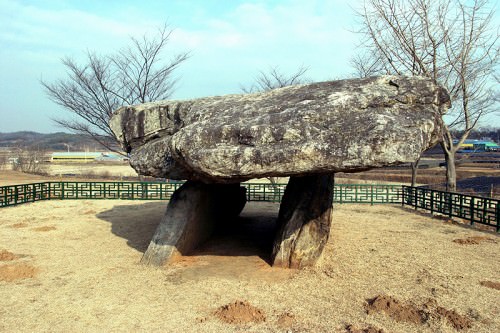
Table Dolmen, Ganghwa, Korea
GEOGRAPHICAL SPREAD
Archaeological evidence illustrates that Bronze Age culture spread down into the Korean peninsula from Manchuria, especially the Sungari and Liao River basins. Mixing with the indigenous Neolithic population, this new culture likely created a societal elite which was responsible for and was honoured by the erection of dolmen tombs. The presence on the Korean islands of Cheju and Kanghwa and areas of Japan of similar dolmens suggests that the cultural wave did not stop at the Korean mainland but also crossed the relatively narrow straits to the Japanese islands.
WHILE DOLMENS USUALLY OCCUR AS A SINGLE ISOLATED MONUMENT, THERE ARE 'CEMETERIES' IN THE SOUTH WHICH CONSIST OF 30-100 EXAMPLES IN CLOSE PROXIMITY.
DESIGN
The dolmen structures can take three different forms and precise configurations differ depending on the region. The first type, more common in the north of the peninsula (across the Han River), is the 'table' or takcha form where one large stone rests horizontally on two or more upright stones often arranged in a square. The second type, known as paduk, has one large flat stone set on top of a mound of smaller stones. The third type, seen more often in the south, has a single large stone laid flat above a small rectangular buried tomb which is lined with stone slabs and usually measuring 2000 x 30 cm. Alternatively, the tomb may consist of a simpler jar burial, perhaps for a child. The first type of dolmen most often occurs in isolation while the others are sometimes found set in rows or groups.
An explanation for the design of dolmens is suggested by the historian Jinwung Kim as follows:
The appearance of dolmen tombs is unique. The round, flat capstone presumably symbolised heaven and the square upright stones represented the earth; people at the time believed that the souls of their chieftains reposed where heaven and earth met. (8)
Outstanding examples of ancient Korean dolmens are the table-type structures on Ganghwa Island which date to c. 1000 BCE in the Korean Bronze Age. Single standing stones (menhirs), unrelated to a burial context and perhaps used as marker stones, are also found across Korea.

Dolmen, Gochang, Korea
EXCAVATION
While dolmens usually occur as a single isolated monument, there are 'cemeteries' in the south which consist of 30-100 examples placed in close proximity, sometimes in a straight line. This would suggest that the individuals interred therein were part of the same elite class, perhaps too, the same dynasty of rulers. Dolmen tombs typically contain the remains of a single individual whose status is revealed by the precious bronze goods within and by the very fact they had a tomb constructed which involved the intense labour of moving the dolmen stones over many kilometres from their source. The enormous size of the stones involved would also suggest that the communities that built them were more than just villages, such was the manpower needed in moving the stones.
Excavations of the tombs under dolmens have revealed bronze goods such as daggers, swords, bells, and mirrors, but also polished stone daggers and burnished pottery. Several tombs also contained jade or amazonite beads, some in the crescent shape known as a gogok which possibly originated in Siberia and represents new life. Gogok (aka kogok ) would reappear in later ornamentation, notably on the golden crowns of the Silla kingdom (57 BCE - 935 CE). One of the richest tombs is at Namsong-ri, containing more than 100 bronze artefacts which besides mirrors and daggers include an axe, chisel, a lacquered birch-bark scabbard, and tubular-shaped jade beads. It may be that some objects were those of a shaman, and there is evidence that shamans were also tribal chiefs in early Korea.
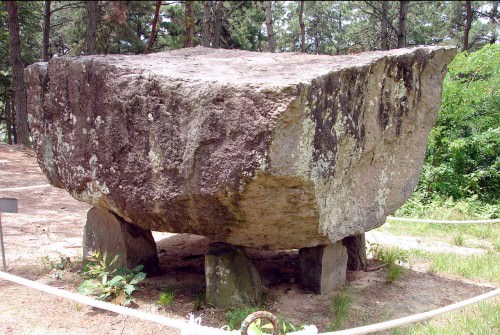
Dolmen, Gochang Korea
UNANSWERED QUESTIONS
One curiosity which historians and archaeologists have yet to solve is why the finds in tombs vary and those with more precious bronze goods are actually the least impressive dolmens. The significance of the size of the capstone has also been debated amongst scholars and whether that signifies the status of the buried individual within. Exactly how the stones were erected is an additional source of disagreement, and another issue is the great similarity between Korean and European dolmens (eg at Carnac and Locmariaquer in France) without any evidence of contact between the two areas at the time of construction. It is clear that these impressive but mysterious monuments will continue to pose puzzling questions, just as they, no doubt, have to the successive ancient cultures of Korea who left them intact for posterity.
This article was made possible with generous support from the British Korean Society.
LICENSE
Article based on information obtained from these sources:with permission from the Website Ancient History Encyclopedia
Content is available under License Creative Commons: Attribution-NonCommercial-ShareAlike 3.0 Unported. CC-BY-NC-SA License